| Pages:
1
..
13
14
15
16 |
jdowning
Oud Junkie
    
Posts: 3485
Registered: 8-2-2006
Location: Ontario, Canada
Member Is Offline
Mood: No Mood
|
|
The fret position chart previously posted has been edited to include an alternative tuning system given by Ibn Sina (otherwise known as Avicenna) in
his treatise Kitab al-shifa (11th C).
This tuning is for a 5 course oud - the strings not being tuned to the usual intervals of a fourth apart throughout but with the Mathna and Zir
courses tuned a major third apart. (as reported by Dr G.H. Farmer in his paper "The Lute Scale of Avicenna").
As with the ud scales given by Al-Farabi and Safi al-Din there are four frets - named first finger, second finger, third finger and fourth finger -
that are equivalent to frets 2, 3, 4 and 5 on the lute (interval size 204, 294, 408 and 498 cents respectively) with a 'Diatonic Anterior' fret at 112
cents being equivalent to the first fret on a lute. All of these ud scales stop at the fourth finger fret which gives the interval of a perfect
fourth. However, in each case I have extended the fretting further up to the 7th fret equivalent on the lute (for comparison purposes).
Ibn Sina gives two further intervals - 'quarter tones' - placed between frets 1 and 2 (139 cents) and between frets 3 and 4 (343 cents).
As the tied on frets can be moved (or removed) to try out alternative scales I shall first locate the frets according to Ibn Sina's scale although
spacing of the 'quarter tone' frets may turn out to be a little too close (about 12 mm or less) to be practical.
In calculating fret positions for tied on gut frets, it is futile to try to achieve an accuracy of better than say, 0.5 mm - which is about the
difference between the 5th fret position calculated at 498 cents Pythagorean compared to that calculated at 500 cents 12 TET.
|
|
|
jdowning
Oud Junkie
    
Posts: 3485
Registered: 8-2-2006
Location: Ontario, Canada
Member Is Offline
Mood: No Mood
|
|
The "Varietie of Lute Lessons" was published in 1610 by Robert Dowland, son of the renowned lutenist /composer John Dowland. Included in the text are
instructions for stringing and fretting a lute of the late 16th C.
To determine fret locations, Dowland first marked the positions on a strip of wood using dividers before transferring these dimensions to the lute
fingerboard. This is likely how the fret locations on early uds were also determined and marked out in the halcyon days before the invention of
logarithms, 'cents' and all of that "good stuff". So - for example - the fifth fret (in Pythagorean temperament) is found by dividing the total string
length into four parts, the distance from the nut to the 5th fret being equal to one part (i.e. a quarter of the string length)
It should be noted that Dowland, in practice, may not have used the fretting scheme that he proposed - his lute being tuned closer to 12 TET. However,
no doubt his intention was to give reasonably close fret locations as a starting point that would then be 'fine tuned' by the player 'by ear'.
Always looking for possible historical links between the Medieval oud and Renaissance lute one comment by Dowland might be of some relevance. He
states:
" Now these frets of late yeeres were but seven in number, as witnesseth Hans Gerle lutenist, citizen and lute-maker of Nurenburge, (for so he
stileth himself in his booke of tableture, printed in 1533) ....... Yet presently after there was added an eight fret: for myselfe was borne but
thirty yeeres after Hans Gerles booke was printed, and all the lutes which I can remember used eight frets ....."
Dowland is referring to Gerle's instruction book for lute and viol of "Musica Teutch" of 1533. Checking my copy of the book, a lute is shown and
described as having 8 frets (although the viols are depicted with 7 frets). Nevertheless, Dowland was likely correct in his general observation that
lutes at the beginning of the 16th C were generally fitted with 7 frets.
This is confirmed in an earlier book "Musica Getutscht" by Sebastian Virdung (Basel 1511). The author discusses three types of lute - the 5 course
lute (the older form of the instrument), the 6 course lute (the most common) as well as a 7 course lute (rare).
He includes a diagram of the fingerboard of the 6 course lute marked out in German tablature up to the 7th fret position. Virdung states that a
lutenist can go beyond the 7th fret, but there are no fixed rules for notating it.
Virdung tells us that the tablature system was invented by Conrad Paumann, renowned organist and lute player of the 15th C.
German tablature was originally designed for a lute of the
15th C i.e. an instrument with 5 courses and 5 frets. Like the tablature for the Medieval oud each tone on the fingerboard is represented by a unique
symbol. By the early 16th C, German lute tablature was adapted to accommodate a lute with 6 courses and 7 frets to the neck joint by adding new
symbols to represent the fret positions 6 and 7 as well as new symbols to represent the additional 6th course. This modification can be seen in
Virdung's finger board engraving (image attached - edited to show the extent of the original lute tablature).The symbols for positions higher than
fret 5 are a repeat of those used for the first 5 frets only doubled 'ee' for 'e' etc. Likewise for the 6th course the symbols for the 5th course are
repeated as 'upper case' figures 'A' for 'a' etc.
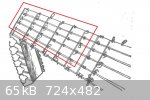
|
|
|
jdowning
Oud Junkie
    
Posts: 3485
Registered: 8-2-2006
Location: Ontario, Canada
Member Is Offline
Mood: No Mood
|
|
Just for interest here is an image of Virdung's lute player. Note the right hand position that is clearly plucking the strings with 'thumb out'
technique rather than 'thumb under' generally accepted today as the style for the early 16th C.
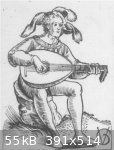
|
|
|
jdowning
Oud Junkie
    
Posts: 3485
Registered: 8-2-2006
Location: Ontario, Canada
Member Is Offline
Mood: No Mood
|
|
Going back to the oud engraving. This is shown with only 7 frets on the fingerboard the last fret being the fourth or little finger fret positioned
part way up the fingerboard (equivalent to the 5th fret of a lute). This is, however, consistent not only with the tuning system of Ibn Sina but also
Safi Al-Din as well as the 10 fret system of Al-Farabi - the latter system providing multiple choices for the oud player (90 or 99 cents anterior, 145
or 168 cents Persian/Zalzalian anteriors, and 294 or 303 cents second finger.
The attached image of the fingerboard of the oud engraving shows the fret layout for the Ibn Sina system together with the equivalent lute fret
positions. The oud tablature overlay is that of Safi Al-Din (with Roman Letters substituted in place of the original Arabic symbols - see "Safi al-Din
al-Urmawi and the Theory of Music " by Dr Fazli Arslan).
The fret spacings on the oud engraving are not to scale but - surprisingly - the relative position of the fourth finger fret is quite accurately
depicted.
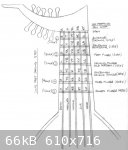
|
|
|
jdowning
Oud Junkie
    
Posts: 3485
Registered: 8-2-2006
Location: Ontario, Canada
Member Is Offline
Mood: No Mood
|
|
For completeness it is necessary to include the fretting system of Ishaq Al-Kindi (9thC). His original work "Risala fi hubr ta'lif al-alhan" - the
oldest surviving source - survives only in fragments - a 17th C transcription of an incomplete 13th C copy.
Al-Kindi describes a 5 course oud with strings tuned a fourth apart. According to Farmer ("The lute Scale of Avicenna"), Al-Kindi's system places
frets at two anterior (mujannab) positions (90 and 114 cents - required primarily because the oud was tuned by fourths). The 90 cent position being
used only for the Bamm, Mathlath and Mathna strings and the 114 cent position only for the Zir and Hadd strings. The remainder of the frets are
positioned, as usual, at 1st finger (204 cents), 2nd finger (294 cents), third finger (408 cents) and 4th finger (498 cents).
So al-Kindi does not include provision for 'quarter tone' fret positions found in the later systems of Al-Farabi, Ibn-Sina and Safi al-Din.
Ibn Sina's alternative scale tuned the Mathna and Zir strings a major third rather than a fourth apart in order to "regularize the admission of the
Zalzalian notes in the second octave" (Farmer).
Given this development, it would only then be necessary to eliminate the 'quarter tone' frets of the Medieval oud for it to be transformed into the
lute (and related instruments like the vihuela and guitar) of the 16th C. - capable of performing the polyphonic music repertoire of Western Europe.
|
|
|
jdowning
Oud Junkie
    
Posts: 3485
Registered: 8-2-2006
Location: Ontario, Canada
Member Is Offline
Mood: No Mood
|
|
The fretting of the oud has been completed today.
The frets have been positioned according to Ibn Sina's alternative scale including frets for the 'quarter tone' Zalzalian Anterior fret (at 139 cents)
and the Zalzalian second finger fret (at 343 cents). Above the 5th (lute) fret position a sixth and seventh fret has been included as a provision to
test the late 15th C 5 course lute configuration.
The first step is to transfer the calculated fret positions onto a strip of wood - the 'fret ruler' let's call it - and then use the ruler to mark the
fret positions on the fingerboard in pencil. This is the procedure described by Dowland in the late 16th C.
Dowland also recommends use of graduated frets in order to keep string action as low as possible. He recommends that the first two frets (nearest the
nut) should be the same diameter as the Countertenor strings of his lute, frets 3 and 4 - the diameter of the great Meane strings, frets 5 and 6 - the
same diameter of the small Meane strings and the remainder of the frets the same diameter as the Treble string. Translating this into gut fret
diameters, my conclusion is that frets 1 and 2 were about 0.9 mm, frets 3 and 4 - 0.7 mm, frets 5 and 6 - 0.6 mm and the remainder- 0.5 mm.
Gerle makes similar recommendations about graduated frets (not certain though as I do not have an English translation of his book - only a copy of the
original on microfilm). Do the early Arab/Persian texts make similar recommendations? I do not know. However, graduated frets will be used for this
project - in 0.5 mm steps from 0.5 mm to 0.9 mm.
I am using fret gut from 'Pyramid' - a good quality product available in 0.5 mm graduations.
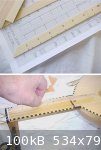

|
|
|
jdowning
Oud Junkie
    
Posts: 3485
Registered: 8-2-2006
Location: Ontario, Canada
Member Is Offline
Mood: No Mood
|
|
The simplest and most economical way to tie a single (rather than double) gut fret is to use a basic 'half hitch' knot pulled as tightly as possible
with the free ends of the gut cut short and melted back to the knot with a fine tipped soldering iron( to prevent the knot from slipping). The use of
pliers to pull each knot as tightly as possible is necessary.
Each fret (starting at the neck joint and working towards the nut) is tied about two positions higher and then carefully slid into place using the
taper of the neck to provide extra tension to each fret. The edges of the fingerboard must be smooth - to prevent a fret catching in any slight crack
or crevice when being slid into position - and slightly rounded so that each fret is held tightly to the fingerboard surface under tension. A
fingerboard with tiled edge is a disadvantage in this respect.
The fret knots are all arranged along the bass side of the fingerboard.
The first fret (next to the nut) is the most difficult to fit as it is the largest in diameter (0.9 mm) and stiff and as there is less space available
in which to slide the fret into position in order to correctly tension it.
Checking the string action at the neck joint - after adjustments made by shaving down the fingerboard at the nut end - is
2.75 mm clearance between the underside of the Hadd (treble) string and fingerboard surface and 3.5 mm under the Bamm (bass) string.
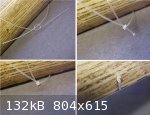
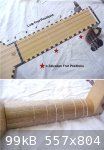
|
|
|
Sazi
Oud Junkie
    
Posts: 786
Registered: 9-17-2007
Location: Behind my oud
Member Is Offline
Mood: مبتهج ; ))
|
|
Does anybody wet the fret gut (as soaking a skin to stretch for a drum) and tie it so as it dries it shrinks tight on the neck? (does it even do
that?)
|
|
|
jdowning
Oud Junkie
    
Posts: 3485
Registered: 8-2-2006
Location: Ontario, Canada
Member Is Offline
Mood: No Mood
|
|
A good question Sazi.
I have never heard of fret gut being applied wet in order to take advantage of the gut shrinking when it dries. Indeed I am not sure (like you) if gut
strings do shrink in length from a wet to dry state. They certainly will absorb moisture, soften and swell in diameter but does this increase in
diameter go with a reduction in length and conversely, does the shrinkage in diameter when dried go with an increase in length? I don't know the
answer so - in the interests of of luthier science I am today running a simple test.
A piece of fret gut measuring 0.025 inches (0.63 mm) in diameter has been immersed in water for 5 hours. The wet gut, now fully saturated with water,
is soft, pliable and quite slippery. It measures about 0.035 inches (0.89 mm) in diameter.
The length of gut has been tied between two nails under tension. The wet gut is so slippery that self tightening 'reef' knots had to be used that
would hold fast under the tension.
Under tension the diameter of the gut measured 0.030 inches (0.76 mm) and the distance between the nails measured 150 mm. The gut under test has now
been set aside in a warm kitchen at about 58% Relative Humidity to dry overnight. So we will see what tomorrow brings!
My guess is that the gut will reduce in diameter and expand in length upon drying. This would result in loose frets if the gut is applied when wet -
but we will see.
Gut strings are made by twisting the gut when wet. Each string is then tied between two pegs on a frame and allowed to slowly dry. As the string dries
the diameter reduces and the string increases in length - slackening on the frame. For several days, additional twists are applied to the string - to
take up the slack - until a stable situation is reached after which time the string is allowed to dry and 'season' for a week or two before being
finished.
When fret gut is tied dry, there is sufficient taper in the neck of the oud or lute to tension a fret adequately when slid into place. Wet gut would
be difficult to tie, might compromise the final precision of the fret diameter after drying and otherwise may offer no other advantage?

|
|
|
jdowning
Oud Junkie
    
Posts: 3485
Registered: 8-2-2006
Location: Ontario, Canada
Member Is Offline
Mood: No Mood
|
|
The piece of fret gut under test has been allowed to dry for 24 hours - under tension - at a relative humidity of around 59%.
The diameter when dry has returned to its original diameter of 0.025 inch (0.63 mm). The gut still retains some tension, stretched between the two
nails - but the tension seems to be less than when the wet gut was first tied to the nails (although this is a subjective judgment). However, the
dried gut now feels uneven to the touch. The attached macro images show why. Fret gut is supplied smooth, uniform and cylindrical but when the gut
absorbs water it softens, swells and increases in diameter. As it swells, the twisted gut filaments also start to unwind so that the original
uniformity of the gut string is lost upon drying.
So, it would seem that wetting the fret gut before application is not to be recommended because:
1) the original uniformity of the gut is compromised.
2) the gut is too slippery when wet to tie a slip knot necessary for initially securing and tensioning the fret on the neck.
3) wet gut does not appear to shrink longitudinally upon drying. If anything it loses tension.
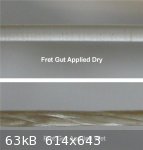
|
|
|
Sazi
Oud Junkie
    
Posts: 786
Registered: 9-17-2007
Location: Behind my oud
Member Is Offline
Mood: مبتهج ; ))
|
|
Oo-er, that's quite a difference in the smoothness and diameter there, obviously unusable, and I hadn't thought of the slipperiness either, though I
should have.
Thanks for taking the time to experiment. Myth Busted!
|
|
|
jdowning
Oud Junkie
    
Posts: 3485
Registered: 8-2-2006
Location: Ontario, Canada
Member Is Offline
Mood: No Mood
|
|
Before declaring 'Myth busted' I am going to try one more test with wet gut to see if it might work with double frets.
Gut double frets were used historically on lutes - they can be tied a bit tighter than single frets and may wear better. A disadvantage - particularly
with larger diameter frets - is that it is sometimes difficult to avoid a small gap between the frets when under tension (caused by the frets being
compressed slightly as they are bent over the edge of the fingerboard).
With low string tension and low action this can result in buzzing of the string - a fault that may be avoided if a single gut fret is used.
The next test will be to wet the gut until soft and pliable and then tie a double fret. As with a single fret, a special slip knot is used to allow
the fret to be tightened onto the neck and fingerboard. It will be interesting to see if the softened gut will mold itself better at the edge of the
fingerboard to eliminate any gap between the frets. It is unlikely that the knot will hold under much tension (due to the slippery nature of wet gut)
but if then allowed to dry, it may then be possible to apply tension in the usual way using the taper of the neck and by sliding the fret down the
fingerboard.
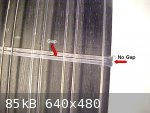

|
|
|
jdowning
Oud Junkie
    
Posts: 3485
Registered: 8-2-2006
Location: Ontario, Canada
Member Is Offline
Mood: No Mood
|
|
The piece of 'fret gut' intended for test 2 (image previously posted as dry fret gut) is not gut at all but, on closer inspection, appears to be
rectified nylon. The 'acid test' is that after soaking in water for 24 hours it shows no signs of absorbing water and swelling. This must have been an
odd piece of instrument string that found its way into my stock of fret gut.
For information and comparison, the attached image is a macro of some high quality fret gut (Pyramid) which - like the nylon string - is uniform and
smooth. The true gut when dry can be identified, under magnification, by twisted fibres that can be seen in a few places.
I have another short piece of fret gut to hand so will use this instead for the second test.

|
|
|
jdowning
Oud Junkie
    
Posts: 3485
Registered: 8-2-2006
Location: Ontario, Canada
Member Is Offline
Mood: No Mood
|
|
After soaking in water overnight, the fret gut has been prepared for test 2. From an original diameter dry of 0.035 inches (0.89 mm) the gut has
swollen to 0.048 inches (1.22 mm) in diameter.
The softened gut was then tied to the neck of one of my spare vihuelas as a double fret - the knot configuration as seen in the attached image. It was
possible to pull the knot tight to the neck without slipping but the gut was too soft and flexible to then push the wet fret down the neckin order to
increase fret tension (note also that the fret fibres have unwound significantly). Due to the softness of the gut it can be seen from the images that
the gap between the fret windings is even more pronounced than if the fret gut had been tied dry. After allowing the gut to dry, this discrepancy
remained and could not be improved by sliding the fret down the neck to increase tension. In fact, due to shrinkage of the gut diameter upon drying,
the fret was found to be fairly loose on the neck.
So - on the basis of these tests - it can be confirmed that gut frets should be tied dry and should not be first softened by soaking in water.
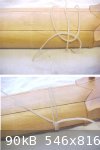
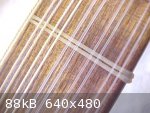
|
|
|
jdowning
Oud Junkie
    
Posts: 3485
Registered: 8-2-2006
Location: Ontario, Canada
Member Is Offline
Mood: No Mood
|
|
With the oud fretted according to the Ibn Sina alternative Pythagorean tuning, the strings have been brought up to pitch with g' (A440) for the top
string. This is about as high as a gut string of 56cm length can be tuned to avoid frequent breakages. It may be possible for silk trebles to be taken
higher than this (a' perhaps?) - but this remains to be tested. For all silk (or gut) strings, the top string must be tuned as high in pitch as
possible so that the thicker bass strings can sound well.
With the first fret at 0.9 mm diameter there was a slight 'buzz' on the first and second string when played 'open' - so either the fret was too thick
or the strings at the nut were too low or a combination of both. Rather than make adjustments to the nut, the first fret diameter has been reduced to
0.85 mm.
First impressions with the Ibn Sina fret layout is that the first and second (Zalzalian) frets are too close to be practical. Also, the first fret
position gives a very 'sharp' first semitone (to my ear). So the first fret has been removed and the 0.85 diameter Zalzalian second fret has been
moved into first position. The Zalzalian frets are a bit of a complication at this point in time so the fret between frets 3 and 4 has been removed
and the whole fretting layout changed to 12 tone equal temperament (12 TET) as a starting point for setting up the oud.
I have also found some experimental silk strings (made for me to test some years ago by Alexander Rakov of New York) so will be fitting these to the
oud to see how it turns out.
With all of this going on everything now seems 'out of tune' so I have taken a break from this project for the past two weeks or so.
In the meantime, Mark Lindley's book "Lutes, Viols and Temperaments" has arrived. This is a small paperback but filled with well researched, well
presented, concise information. Lindley confirms that the lute of the 16th C and later was most commonly fretted (close to) an equal temperament (i.e.
like the modern guitar) but that a meantone temperament seemed best suited to some the early vihuela music (Moorish oud connection?).
Pythagorean fretting may be a possibility for the 15th C lute repertoire but impossible to verify as no lute tablature survives from this period.
Lindley also investigates Just Tuned (Pure Intonation) fretting but concludes that this was more theoretical than practical for a fretted 12 tone
octave system.
Many musicians and composers (e.g pianist Erik Satie) have, in recent history, 'successfully' experimented with Just Intonation. However, for fretted
instruments the complexities would seem to outweigh the practicalities. For example, David Canright has developed a classical guitar (a Justly-Tuned
Guitar) with Just Intonation fretting that has a total of 52 frets - an instrument that he confirms "is very difficult to play"(!)
Fibonacci geometry is included!
http://home.comcast.net/~dcanright/
|
|
|
jdowning
Oud Junkie
    
Posts: 3485
Registered: 8-2-2006
Location: Ontario, Canada
Member Is Offline
Mood: No Mood
|
|
For information, two varieties of meantone tuning - 1/4 comma and 1/6 comma - have been plotted for comparison with the earliest surviving oud
fretting arrangement given by Al-Kindi
(9th C). Note that for the first two (anterior 'mujannab')) frets on Al-Kindi's scheme of things for a 5 course oud (90 cents and 114 cents
Pythagorean) - fret #1 is only used for the (bass) Bamm, Mathlath and Mathna strings and fret #2 only for the treble Zir and Hadd strings. (I have
added the "missing" 6th and 7th lute equivalent frets for comparison).
The equal tempered lute fretting 'splits the difference' between the two frets for the lute fret #1 position.
According to Mark Lindley a variety of meantone fretting may have been used for the early 16th C lute repertoire - particularly in Germany and Spain.
Pythagorean fretting for the lute may have been used prior to the 16th C but there is no surviving music for lute from this period to verify this
speculation. Otherwise - for the solo lute repertoire of the 16th/17th C at least - equal temperament fretting (more or less) prevailed.
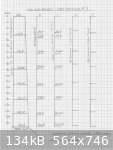
|
|
|
Sazi
Oud Junkie
    
Posts: 786
Registered: 9-17-2007
Location: Behind my oud
Member Is Offline
Mood: مبتهج ; ))
|
|
Thanks John, it's nice to have all this info in one place.
Just checking your fingerboard charts against my notes, and in your chart here:
http://www.mikeouds.com/messageboard/viewthread.php?tid=8488&go...
you have Zalzal's wusta - second finger - at 343c, and in my notes from Safi Al Din I have it listed as 384c... I don't have the original any more
and am just wondering if I inadvertantly made a copying mistake here?
Thanks, S
|
|
|
jdowning
Oud Junkie
    
Posts: 3485
Registered: 8-2-2006
Location: Ontario, Canada
Member Is Offline
Mood: No Mood
|
|
Hi Sazi - thanks for your question.
I do not have access to the original early Arabic/Persian texts (or the ability to translate them if I did) so must depend upon the work of others.
Also I have not taken the time to verify by calculation the data presented by other researchers in their translations - often from early
Arabic/Persian to German/French and then to English - so, although there is potential scope for inadvertent error I have, so far, taken this data at
'face value'.
The second finger Zalzal Wusta fret position seems to have varied over the centuries. According to Farmer, Al-Farabi places the Zalzalian second
finger fret at 355 cents. By the time of Ibn Sina this had changed to 343 cents.
According to Dr Fazli Arslan's recent detailed study of Safi al-din al Urmawi's 'Theory of Music' , the 6th note on his scale (wusta al-zalzal) is
given by the ratio 8192/6561 equivalent to 384,36 cents (a diminished fourth, according to my
convenient 'Ratio to Cents' conversion chart). So - if correct - this brings this fret position closer to 400 cents 12 TET rather than a 'quarter
tone' placement.
(BTW, you reference my 'old oud' fingerboard chart (giving the Ibn Sina fretting) but I take it that you meant to link to the 'fret position' (#1)
previously posted?)
|
|
|
Sazi
Oud Junkie
    
Posts: 786
Registered: 9-17-2007
Location: Behind my oud
Member Is Offline
Mood: مبتهج ; ))
|
|
Quote: Originally posted by jdowning  |
(BTW, you reference my 'old oud' fingerboard chart (giving the Ibn Sina fretting) but I take it that you meant to link to the 'fret position' (#1)
previously posted?)
|
Ahh... and there you have it...384... I don't know how I overlooked that one!
Thanks again, S
|
|
|
jdowning
Oud Junkie
    
Posts: 3485
Registered: 8-2-2006
Location: Ontario, Canada
Member Is Offline
Mood: No Mood
|
|
I have not had time this year to make a full set of silk strings according to the directions given in the Kanz al-Tuhaf. However, in order to make
some progress for this project, I do have some silk lute strings that might be used for initial tests - made for me some years ago by Alexander Rakov
of New York. These are strings that have been previously used for testing but which should still have some useful life left in them. Alexander's
strings are beautifully crafted - made in the fashion of the ancient Chinese strings i.e. from raw silk (with added linear mass) and with the larger
diameter strings over-spun with silk windings on a twisted silk core (for extra flexibility).
I need to check to see what diameter strings I have to work with but the attached calculation sheet gives the required diameters according to the
Mersenne-Taylor Law for thin vibrating strings. These calculated diameters are just a starting point and so may vary according to actual performance
of the strings. For example, the linear density of the strings is likely to be somewhat greater than the 1.3 gm/cc assumed in the calculations or
string tensions or overall pitch level of the strings may be varied - all helping to reduce string diameters for better performance - particularly of
the Mathlath and Bamm strings.
So, let's see how it goes from here.
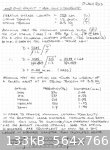
|
|
|
jdowning
Oud Junkie
    
Posts: 3485
Registered: 8-2-2006
Location: Ontario, Canada
Member Is Offline
Mood: No Mood
|
|
At this point it is time it may be informative to perform a "reality check" using the string making data provided by the 14th C. Kanz al-Tuhaf that
determines string diameter according to the number of silk threads used to make each string - i.e. Hadd 16 threads, Zir 24 threads, Mathna 32 threads,
Mathlath 48 threads and Bamm 64 threads.
It can be seen from the attached calculation that the diameters given by the Tanz al-Tuhaf - starting with a Hadd string of 0.44 mm diameter - are
significantly less than those given by the Mersenne - Taylor Law.
This implies that the data in the Kanz al-Tuhaf may be incomplete - that there is a missing step. This possible discrepancy will be discussed in more
detail later in the 'Silk Strings - Making Sense of the Historical Data' topic on this forum.
In the meantime - referring to the Mersenne - Taylor formula - it can be seen that the discrepancy in diameters might (in part or in total) be
accounted for by:
1) reducing string tension as string diameter is increased (a standard procedure with modern lute strings).
2) adding linear mass to a string by soaking it in heavy metal salts ('silk weighting' as it is known in the silk industry).
3) wrapping a silk string core with a silk string or ribbon (equivalent to a modern over-spun string) to provide additional linear mass with minimal
effect on lateral flexibility of a string. This is how the ancient Chinese made their larger diameter silk strings. The early Chinese texts only gave
the number of threads required to make the silk core - not the wrappings. So, for example and perhaps likewise, the Bamm string in the Kanz al-Tuhaf
may have had a core of 64 threads to which may have been added an unspecified mass of additional silk as a wrapping - and hence the diameter
differences.
More to follow!
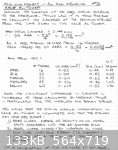
|
|
|
jdowning
Oud Junkie
    
Posts: 3485
Registered: 8-2-2006
Location: Ontario, Canada
Member Is Offline
Mood: No Mood
|
|
The oud is now fully strung with silk strings and ready for testing.
These are experimental silk strings made some years ago by Alexander Rakov of New York for my 60 cm string length lute so were not designed for this
oud. Nevertheless, I was able to put together a set of strings that seem to work quite well.
The Hadd string is 0.43 mm diameter, Zir 0.52 mm diameter, Mathna 0.76 mm diameter. These are simply twisted strings made from raw silk and 'cooked'
in the ancient Chinese fashion (ie with the Sericin gum intact).
For the Mathlath and Bamm strings I have used silk cored wrapped strings. The Mathlath string was originally made for the lute 5th string and the Bamm
for the lute 6th string but have been 'moved up a step' on the oud (to 4th and 5th courses) to achieve a higher string tension approximately equal to
that of the top three courses. The Mathlath string measures 1.08 mm outside diameter with a silk core measuring 0.54 mm diameter. The Bamm string
measures
1.4 mm outside diameter with a core diameter of 0.60 mm.
None of the strings have been 'weighted' hence the relatively large diameter of the basses (compared to modern wire wound strings).
The strings are tuned a fourth apart with the top string at maximum workable pitch of f sharp (370 Hz @A440). (I did try taking the top string to G
but one of the Hadd strings failed after about a week - so that pitch is judged to be the upper limit).
Tuning the top string to maximum pitch (avoiding frequent breakage) allows the thicker bass strings to respond better at higher tension.
The string diameters available do not give exactly equal tension but are close enough ('by feel') for initial trials. (Calculated tensions are Hadd
3.5 Kg, Zir 2.7 Kg and Mathna 3.3 Kg).
The wrapped strings have been beautifully constructed by Alexander - looking like a 'string of pearls' according to the ancient Chinese string
makers.
Sound clip to follow.
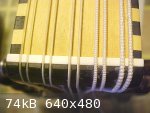
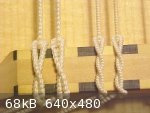
|
|
|
jdowning
Oud Junkie
    
Posts: 3485
Registered: 8-2-2006
Location: Ontario, Canada
Member Is Offline
Mood: No Mood
|
|
The oud has been fitted with graduated diameter tied on gut frets (reducing in diameter from nut to neck joint) to keep the 'action' as low as
possible. For initial trials with silk strings the frets (total 7 to the neck joint) have been spaced according to Western 12 tone equal temperament -
familiar territory for now - after which the various historical Pythagorean/Arabic/Persian systems (with intermediate fret positions - or 'quarter
tones') will then be tested for comparison. The five double courses are tuned a fourth apart.
I have decided to use the more historically appropriate plectrum (mizrab) for the trials - rather than finger style plucking. I have no previous
experience of using a plectrum so this will be a useful learning experience.
To minimise wear and tear on the silk strings a mizrab has been cut from a strip of thick, hard cow hide leather - softer and gentler than a feather
quill (risha) or one made from bone, horn or plastic. I figure that the leather is likely similar to tree bark that was once used in ancient times.
So here is the first sound clip of the oud strung completely in silk - plucked inexpertly with a leather mizrab - just to demonstrate the range from
open bass (Bamm string) to the top string (Hadd) as far as the neck joint (7th fret).
The sound recording has been made in an acoustically absorbent room (lined wall to wall, floor to ceiling with books). The digital recorder (Zoom H2)
was positioned about a metre from the oud. Audacity software was used to select the sound clip and convert to MP3 - otherwise the audio recording is
'raw' - as is - and unedited.
For such a small instrument (56 cm string length), the projected sound volume and bass response in particular is (for me) encouraging. Also the
trebles 'sing' with a bright 'silvery' tone that may be a characteristic of silk strings.
Checking earlier postings - when the topic of Helmholz resonances was discussed (page 10) - it was estimated that the Helmholz resonance of the oud
body might be optimal at a frequency of around 169 Hertz. This falls close enough to the 4th string (Mathlath) frequency of 156 Hertz to add support
to the Helmholz resonance theory (at least as applied to this oud).
The strings were plucked at a location mid point between the two sound holes which seems to give optimum results re: dynamic range of sound volume. So
the wide spacing of the two relatively large diameter sound holes may make historical sense - to avoid damage to the sound holes from the plectrum
perhaps?
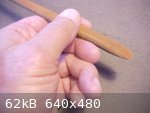
Attachment: Old Oud Silk String AudioTest 1.mp3 (314kB)
This file has been downloaded 553 times
|
|
|
BaniYazid
Oud Junkie
    
Posts: 225
Registered: 8-20-2010
Location: France
Member Is Offline
|
|
Nice and clear sound, very refreshing, fell like someone resting in the shade on a hot day.
|
|
|
fernandraynaud
Oud Junkie
    
Posts: 1865
Registered: 7-25-2009
Location: San Francisco, California
Member Is Offline
Mood: m'Oudy
|
|
It has neither the lute's nor the oud's characteristic timbre. If I didn't know what it was, I'd guess a Japanese or Chinese instrument, maybe a lute
like a Shamisen, a Pipa, maybe a Koto. Just put some vibrato into it!
|
|
|
| Pages:
1
..
13
14
15
16 |